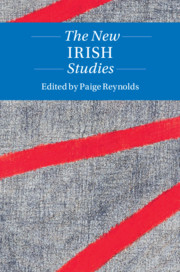Book contents
- The New Irish Studies
- Twenty-First-Century Critical Revisions
- The New Irish Studies
- Copyright page
- Contents
- Notes on Contributors
- Acknowledgments
- Introduction
- Part One Legacies
- Part Two Contemporary Conditions
- Part Three Forms and Practices
- Chapter 11 Ireland’s Real Economy: Postcrash Fictions of the Celtic Tiger
- Chapter 12 Northern Irish Poetry
- Chapter 13 Essayism in Contemporary Ireland
- Chapter 14 Killers, Lovers, and Teens: Contemporary Genre Fiction
- Chapter 15 “One Hundred Years a Nation”: New Modes of Commemoration
- Chapter 16 Coda: A New Irish Studies
- Index
Chapter 15 - “One Hundred Years a Nation”: New Modes of Commemoration
from Part Three - Forms and Practices
Published online by Cambridge University Press: 18 September 2020
- The New Irish Studies
- Twenty-First-Century Critical Revisions
- The New Irish Studies
- Copyright page
- Contents
- Notes on Contributors
- Acknowledgments
- Introduction
- Part One Legacies
- Part Two Contemporary Conditions
- Part Three Forms and Practices
- Chapter 11 Ireland’s Real Economy: Postcrash Fictions of the Celtic Tiger
- Chapter 12 Northern Irish Poetry
- Chapter 13 Essayism in Contemporary Ireland
- Chapter 14 Killers, Lovers, and Teens: Contemporary Genre Fiction
- Chapter 15 “One Hundred Years a Nation”: New Modes of Commemoration
- Chapter 16 Coda: A New Irish Studies
- Index
Summary
Our contemporary moment sees a new impetus toward commemoration, fueled by the government-sponsored “Decade of Centenaries” program, spanning the years 1912–1922, from the centenary of the Ulster Covenant to the Irish Civil War. From the diverse cultural initiatives that have resulted to date, an imperative to expose and question what is memorialized, or what has been allowed to be of public matter, is already proving to be the most powerful feature of this commemorative decade. What has also become evident is the importance of new technologies and new modes of communication that look backward and forward: They invite new ways of thinking about the past that are already proving to be transformative in the present. Central to these activities is the development of new audiences and networks for the reception of Irish culture and, as this chapter also demonstrates, many offer the individual artist and their works a newly invigorated public role.
- Type
- Chapter
- Information
- The New Irish Studies , pp. 259 - 274Publisher: Cambridge University PressPrint publication year: 2020
- 1
- Cited by

